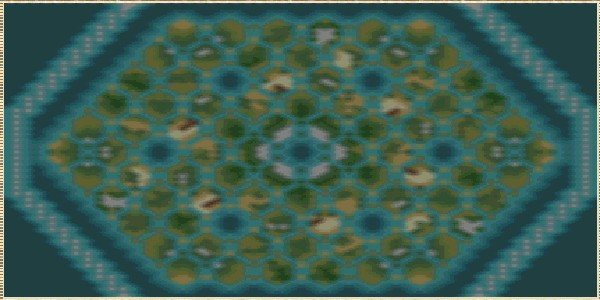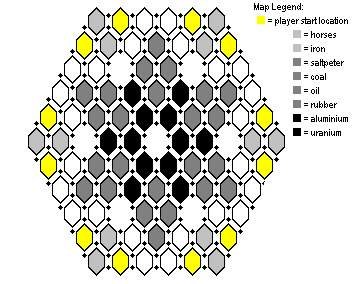The general design concept here is to encourage new game strategies through use of map geometry, not through mods or rule changes.
series history:
Strategic Game Board #5: Standard Hex Board, 100x100
You're soaking in it.
SGB #4: large hex board, 140x140
thread:
http://forums.civfanatics.com/showthread.php?s=&threadid=18019
SGB #3: huge hex board, 180x180. see a trend?
thread:
http://forums.civfanatics.com/showthread.php?s=&threadid=17382
SGB #2: 'waffle-iron' pattern, 120x106
Featured on Civ3.com!

thread:
http://forums.civfanatics.com/showthread.php?s=&threadid=15610
SGB #1: 'waffle-iron' pattern, 200x130
thread:
http://forums.civfanatics.com/showthread.php?s=&threadid=14695
What would you like to see in the next game board? Comments, suggestions, and recomendations can be posted in this thread, or sent directly to
beerengine@mad.scientist.com
Map Notes for Strategic Game Board #5:
=Map Stats=
- Map designed for 6 or 12 civs. Playable by up to 12 civ.
- Overall size 100x100. (default standard map size -- the only rule change is to allow 12 civs)
- 12 player start locations
- 'Board Game' style layout, using 72 hexagons
=Geometry=
Like SGB's #3 and #4, this is a hexagon-based map. For those of you following along at home, you might have noticed that all I do is shave off enough outer rings to make the hex map fit the next size down. So sue me. I'm not really saving any time here -- while the basic map is thus very similar, the smaller sizes do lead to other design and balance problems.
Hexagons connect at six points (naturally) to neighboring game hexes. A small land bridge connects three hexes at a corner.
The game board hexagons are larger than the old game board 'squares' (which I used in a waffle-iron pattern as seen on maps #1 and #2). You should be able to fit 2 (maybe 3) cities on each hex, more or less comfortably with a little overlap.
The map is made up of 72 hexes. There are 7 inland seas, which are in fact just holes where an intervening hex would have been. A map screenshot and 'outline' were posted earlier in this thread. (you had to scroll past them to read this)
For those of you who are curious: This map is half the size of SGB #4, and a quarter the size of SGB #3. It would seem Firaxis did not pick their default map sizes at random.

One additional note: I moved all start locations further out on this map. Each player start location is now coastal, with access to the exterior sea (not just one of the many lakes). This should help promote additional trade, since there is the potential, at any rate, that you can access other civs through their harbors.
=Resources=
As the maps get smaller, shoe-horning in all the resources gets bothersome. Some concessions had to be made to save the gameplay elements I liked about the larger maps, while not absolutely drenching the map in resources.
Resource placement for this map is similar to that on SGB's #3 and #4. Key hexes have clusters of strategic resources. There are six clusters for each of the eight strategic resources. Starting from the outside edge, they are placed in roughly concentric rings, with the 'modern' resources are at the center, and the first-visible resouces at the outside. Uranium is at the 'bullseye' of the map.
Every start position has close access to both horses and iron... almost...
Actually, every *pair* of start locations has such access. Depending on how many civs are in play, you are not guaranteed posession of the early resources.
Scarcity is mitigated by placing resources in clusters of three. If you find an oil cluster, for example, you not only meet your own needs but have two surplus oil to trade. There is also a possibility that two civs could split control of a cluster, sharing the same oil field, so to speak. Uranium is a noteable exception: on this map, there are only 1 or two uranium at each uranium placement, and only 9 uranium total.
Luxury resources are also scarce, with only 3 clusters of each. Despite the low numbers of luxury clusters, there should be enough for you to trade around with.
All map real-estate is valuable. Every hex has something in it, either a resource or a player start position.
Overall, resources should seem balanced for 6-8 civs. A 12 civ game on this map might leave you feeling a bit 'hungry' for some resources.
=Strategy=
While the map has numerous choke points to place defenders, there will be less time to get units into place. In a 12 civ game, you face 2 neighbors, each close enough to cause real problems -- while you do have some room to expand, to get to the vital strategic resouces you'll have to try and face down at least one rival before beginning other expansions.
Taking and holding key hexes becomes important, not just to grab resources but to block the future expansion routes of other civs.
Knocking out at least one opponent may be one of your early goals, particularly if he is right there on your flank.
It's a single-continent land board, but this is also a smaller map than any of my earlier offerings. Your ships will come in handy, to move units around the outside edge of the board, or (maybe) to take shortcuts across the small inland seas. I've got a sea wall in place so you shouldn't able to get units to the other side of the map. (though some fun things might be done with aircraft

)
That does it for this one. I'll be doing one more hex map (you guessed it, 80x80) and then I'll begin looking for a new pattern, or a new variation on an older pattern. Any suggestions out there?





 )
)